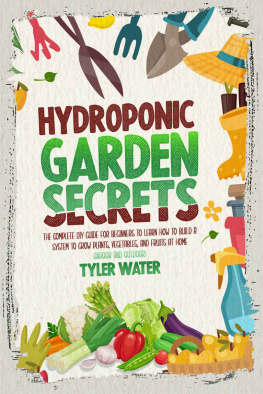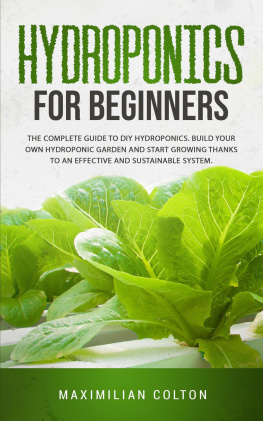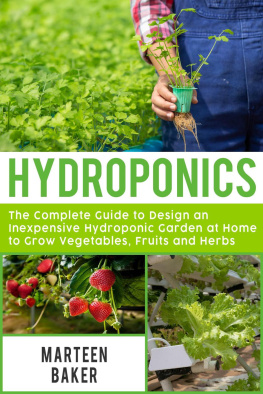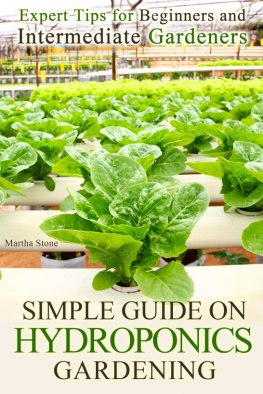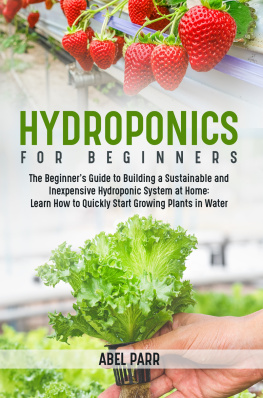Tyler Water - HYDROPONICS GARDEN: The Complete Diy Guide For Beginners To Learn How To Build A System To Grow Plants, Vegetables And Fruits At Home (Indoor And Outdoor) (Gardening for Beginners)
Here you can read online Tyler Water - HYDROPONICS GARDEN: The Complete Diy Guide For Beginners To Learn How To Build A System To Grow Plants, Vegetables And Fruits At Home (Indoor And Outdoor) (Gardening for Beginners) full text of the book (entire story) in english for free. Download pdf and epub, get meaning, cover and reviews about this ebook. genre: Children. Description of the work, (preface) as well as reviews are available. Best literature library LitArk.com created for fans of good reading and offers a wide selection of genres:
Romance novel
Science fiction
Adventure
Detective
Science
History
Home and family
Prose
Art
Politics
Computer
Non-fiction
Religion
Business
Children
Humor
Choose a favorite category and find really read worthwhile books. Enjoy immersion in the world of imagination, feel the emotions of the characters or learn something new for yourself, make an fascinating discovery.
- Book:HYDROPONICS GARDEN: The Complete Diy Guide For Beginners To Learn How To Build A System To Grow Plants, Vegetables And Fruits At Home (Indoor And Outdoor) (Gardening for Beginners)
- Author:
- Genre:
- Rating:4 / 5
- Favourites:Add to favourites
- Your mark:
HYDROPONICS GARDEN: The Complete Diy Guide For Beginners To Learn How To Build A System To Grow Plants, Vegetables And Fruits At Home (Indoor And Outdoor) (Gardening for Beginners): summary, description and annotation
We offer to read an annotation, description, summary or preface (depends on what the author of the book "HYDROPONICS GARDEN: The Complete Diy Guide For Beginners To Learn How To Build A System To Grow Plants, Vegetables And Fruits At Home (Indoor And Outdoor) (Gardening for Beginners)" wrote himself). If you haven't found the necessary information about the book — write in the comments, we will try to find it.
The hydroponic garden is a space in which plants and flowers grow without resorting to the use of earth and classic soil, but simply creating a favorable environment for plant growth.
But how do you make plants grow without soil?
The secret of the hydroponic garden - and more generally of all hydroponic crops - is in the use of water (or other types of substrates alternative to soil, such as perlite, sand, clay, etc.) in which the nutrients are dissolved that plants normally find in traditional soil.
One of the advantages of the hydroponic garden is the ability to create it anywhere, in any available area of the house, even in small and dimly lit spaces in the home.
Generally, when you talk about the garden and hydroponic gardening you tend to think that it is a very complex, difficult, and expensive technique because it requires the use of support equipment. In reality, by optimizing spaces and tools, it is possible to create a hydroponic garden at home that is much richer and more abundant than what would be obtained with traditional cultivation, and without spending a fortune.
With this book in your hands, you are going to learn how to choose the best plants to grow and maintenance techniques for healthy and vibrant-looking plants.
In this book, you will:
- Learn Hydroponic Growing Systems and Equipment to know how to take the most from your seeds and have the knowledge to choose the best for your needs and goals.
- Know How to Choose the Right Place For Your Garden to create a vertical green wall in your home environment in the best place for what you want to grow.
- Realize Hydroponic Cultivation Guarantees A More Sustainable, Faster, And Quality Agriculture because plants grow out of the ground, in an environment free of pests and diseases.
- Discover Hydroponic Cultivation Improve Quality and Taste of Produce because the system utilizes quality of nutrients and clean water under controlled environment without pesticides or herbicides.
- Understand Hydroponics Saves Water. The efficiency of a hydroponic system may save up to 90% of water. Using hydroponics, not only will you help protect amongst one of our most significant assets, you will additionally lessen your water bill, gaining a competitive edge.
& Lot More!
It can be very confusing to get started in hydroponics. Figuring out how it all works, how to choose a system, what to grow, and even how to grow are all challenging.
But dont worry, time has come!
This guide will give you everything you need to know about the basic types of growing systems in hydroponics, and how to start growing plants, herbs, fruit and vegetables all year with your hydroponics system.
By the time you have finished reading this book, you will have a better understanding of what hydroponics is, what systems best suits your lifestyle and budget, as well as how to start setting up your hydroponics system.
Order Your Copy Now and Start Gardening to Become a Hydroponics Expert!
Tyler Water: author's other books
Who wrote HYDROPONICS GARDEN: The Complete Diy Guide For Beginners To Learn How To Build A System To Grow Plants, Vegetables And Fruits At Home (Indoor And Outdoor) (Gardening for Beginners)? Find out the surname, the name of the author of the book and a list of all author's works by series.

